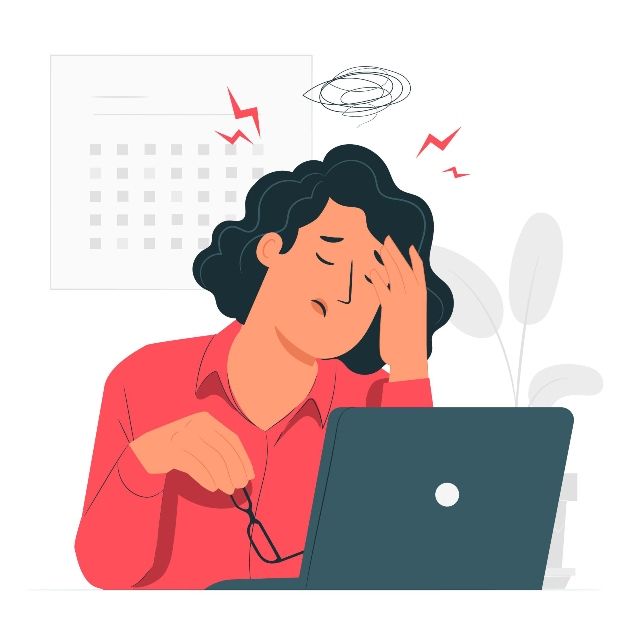The Trap of Dissatisfaction–And Its Surprising Upside

Vector image is from freepik.com by @storyset
“I can’t get no satisfaction.” -The Rolling Stones
We all go through hard times in life, with setbacks and disappointments. It only becomes a trap if we experience a chronic sense of dissatisfaction—not being content or at peace with what we have.
It’s a trap if we develop an enduring sense of disappointment, of never feeling at peace. Or a chronic craving or dwelling on things we lack. In this state, we’re missing a sense of acceptance, of contentment, of serenity.
Such dissatisfaction can be a sign of maladaptive perfectionism—when our personal performance standards are hopelessly high and we’re extremely self-critical in judging ourselves. (See my article on “The Perfectionism Trap—And How to Escape It.”) It can also lead to a negative spiral when things don’t go as we hoped. In this spiral, discouragement accompanies any imperfection. Not a good place to be.
Some people get addicted to the dramas and disappointments of life. It becomes part of their identity. They use them to rile up their ego with outrage or grievance. It can give them a strange sort of satisfaction in the moment, but overall they’re really just making themselves miserable for large swaths of their life.
“Most people are in love with their particular life drama…. The ego runs their life. They have their whole sense of self invested in it.” -Eckhart Tolle, The Power of Now
What Leads to Dissatisfaction
There are many external triggers of dissatisfaction, but what causes people to fall into the trap of chronic dissatisfaction in which they view life through a lens of disappointment or bitterness?
Here are some of the most common sources of such dissatisfaction:
- Resisting what happened to us in the past and hanging on to it instead of letting it go.
- Getting so caught up in hoping for a better future that we neglect the present moment or discount it because it hasn’t yet brought us our desired future.
- Not distinguishing between our needs and wants, and then lamenting that we haven’t yet attained things which turn out to be fanciful or unnecessary. (Note: We should also be mindful of the doom loop that keeps us in jobs we don’t like in order to meet those supposed “needs.” See my article, “Golden Handcuffs: Stuck in a Job You Don’t Like?”)
- Getting swept up in “negativity bias.” (Researchers have discovered that negative things like troublesome feelings or frustrating social interactions often influence our mental state much more powerfully than positive or neutral things.)
“Constantly scanning the world for the negative comes with a great cost. It undercuts our creativity, raises our stress levels, and lowers our motivation and ability to accomplish goals.” -Shawn Achor, The Happiness Advantage
- Having a “scarcity mindset”—a pervasive sense that we don’t have enough (time, money, happiness, etc.), flowing from an often subconscious belief that life is a zero-sum game with a brutal competition for scarce resources.
- The unrealistic and pernicious expectation that we’re supposed to be happy all the time. In our culture today, we tend to worship at the alter of happiness. Whenever we encounter negative emotions like frustration, sadness, disappointment, or regret, we assume something’s wrong with us, and that it needs to be fixed (often with medication or numbing behaviors). (See my Happiness Series.)
You may like this: 80-Year Study Finds The Secret to Happiness
“Happiness is not a mental state that can be permanently won…. By misunderstanding happiness, the modern conception increases the likelihood of disappointment.” -Nat Rutherford, University of London
- Falling into the “expectations trap”: When there’s a gap between our current versus expected life satisfaction, and when we go beyond aspirations and into the realm of attachment to our expectations, we feel disappointment or judge our lives negatively, even though our life may actually be going quite well. It stems from what Buddhists call “the wanting mind,” a major source of our own suffering.
- Engaging in unfair and unhelpful comparisons. Many of us fall into the comparison trap fairly often, comparing ourselves to others on things that are fairly superficial. Even worse, we tend to compare ourselves to an unrealistic standard, such as the richest person we know, or the most outwardly successful or beautiful. A recipe for disappointment.
(Take the Traps Test--Common Traps of Living: We all fall into traps in life. Sometimes we’re not even aware of it, and we can’t get out of traps we don’t know we’re in. Evaluate yourself with our Traps Test.)
Signs of Dissatisfaction
How do we know if we’re in such a dissatisfaction spiral? Here are six of the most common signs of it:
- Never feeling successful enough.
- Constantly feeling behind.
- Overwork and burnout in a relentless and grasping pursuit of success, driven by a need for recognition or approval from others.
- Resentment at our station in life or at the success of others.
- Recurring thinking patterns about being a victim in a world that’s hopelessly unfair.
- Habitual patterns of complaining about things, so much that it becomes a routine that defines our relationships with certain people and would leave a gaping hole in that relationship if we didn’t have things to complain about. These neural grooves can be deep in our brains and take time to reprogram.
So far, we’ve seen the signs and causes of negative dissatisfaction spirals. But we should pause here and note an important nuance: while dissatisfaction can make us miserable if taken too far, it also has some surprising and important upsides.
Not So Fast—The Important Upsides of Dissatisfaction
What are the potential upsides of dissatisfaction? It can be a source of motivation and urgency for us, helping us move forward and drive progress.
Dissatisfaction can provide needed motivation to change. To overcome.
“Until you get dissatisfied, you won’t do anything to really move your life to another level. Dissatisfaction is a gem. If you’re totally satisfied, you’re going to get comfortable. And then your life begins to deteriorate.” -Tony Robbins
There’s a signaling function at work here. Chronic dissatisfaction can serve as a sign that there’s a deeper problem in our lives that needs attention. It radiates angst so we’ll pay attention.
In some case, it can also serve as a conduit, via painful feelings and disturbance, to great music and art. We’d be crazy to wish that on ourselves, but we humans are resilient, and sometimes our creative powers are enhanced by dark and painful experiences.
So let’s clarify that, while we can use dissatisfaction as motivational fodder when necessary, we want to avoid the dissatisfaction doom loop that has us walking around in a fog.
There’s a beautiful tension here. We can do both. We can love our lives as they are, as Hal Elrod entreats us, even while we’re working on creating the life of our dreams.
What to Do
How to avoid or escape the trap of chronic dissatisfaction? Here are 21 of the best dissatisfaction destroyers that we know of:
1. Let go of our reactive, automatic, negative thought patterns that only make things worse for us in already difficult situations (e.g., rumination).
2. Recognise our negative thoughts when they appear, let them go, and rewire them by bringing in newer, better thoughts, over and over again, until new thought patterns appear.
3. Focus on what we have instead of what we lack, and on what’s going well instead of only on what’s not (remembering that we have a negativity bias to compensate for).
4. Cultivate an abundance mindset, recognising that things like love, happiness, connection, and opportunity can be renewable resources when approached wisely.
5. Engage in centering practices, like deep breathing, meditation, savoring, and raising our gaze to the sky or horizon, helping us regain perspective and calm.
6. Recognise that happiness doesn’t come from our circumstances being perfect or always in line with our expectations but rather from crafting our life and work so that we lead a good life as we define it.
7. Avoid setting unrealistic expectations.
8. Let go of rigid expectations about how things will go and leave more room for the unexpected—and even challenges, recognizing that they can help sharpen and improve us.
9. Recall that outcomes are outside our control and that we can only control our own actions and mindsets.
“You have power over your mind—not outside events. Realise this, and you will find strength.” -Marcus Aurelius
10. Cultivate a growth mindset (a belief that our intelligence, abilities, and talents can be developed, which tends to come with an appreciation for challenges instead of resentment of them).
Discover: Fixed vs Growth Mindset: Which Do You Have?
11. Focus on serving and giving to others instead of whether we’re satisfied or not.
12. Cultivate a gratitude practice in which we regularly return to the things we’re thankful for.
13. Design our work and leisure activities to facilitate more “flow” states in which we’re so absorbed in activities that we lose track of time. In such a state of optimal experience, dissatisfaction is impossible.
14. Build more of our passions into our life and work.
15. Apply our strengths to projects, groups, and causes that feel meaningful.
16. Rewrite the story we tell about ourselves from one of disappointment and lack to one of appreciation and hope.
17. Stop taking things so personally; we all face ups and downs, and it turns out that we’re not actually the center of the universe.
18. Work at being more accepting of things as they are, as opposed to how we predicted or hoped they would be.
19. Develop practices for detaching from heated situations and rising above them without getting engrossed in them, including meditation or mindfulness practices.
20. Recognise that being judgmental—about ourselves as well as others—is a trap that only leads to misery (for us and others).
21. Reduce the call of our ego (which is focused on accumulation, praise, winning, success, and control) by tapping into the call of our soul (which is grateful for the abundance of life and not interested in petty dramas or comparisons with others).
“Fulfillment is not a matter of self-improvement. It involves a shift away from the ego’s agenda, turning from externals to the inner world. The soul holds out a kind of happiness that isn’t dependent on whether conditions outside are good or bad.” -Deepak Chopra
Final Thoughts
In the end, we can use dissatisfaction when it suits us to light a motivational fire, but not so much that we walk around in a fog of angst all the time, lamenting the sorry state of our lives or the things we don’t have. Is that really a good way to answer the gift of life?
Here’s the key: use dissatisfaction to fuel us when necessary, and don’t let it vanquish our spirit.
If we can learn to let go of the chronic dissatisfaction that follows many disturbances, or at least reduce its effect and frequency, perhaps we can create our own personal weather system around our overactive minds more conducive to enjoying our days and uplifting others.
This article was also published on Gregg Vanourek's LinkedIn.
Leadership
Gregg Vanourek is an executive, changemaker, and award-winning author who trains, teaches, and speaks on leadership, entrepreneurship, and life and work design. He runs Gregg Vanourek LLC, a training venture focused on leading self, leading others, and leading change. Gregg is co-author of three books, including Triple Crown Leadership (a winner of the International Book Awards) and LIFE Entrepreneurs (a manifesto for integrating our life and work with purpose and passion).





